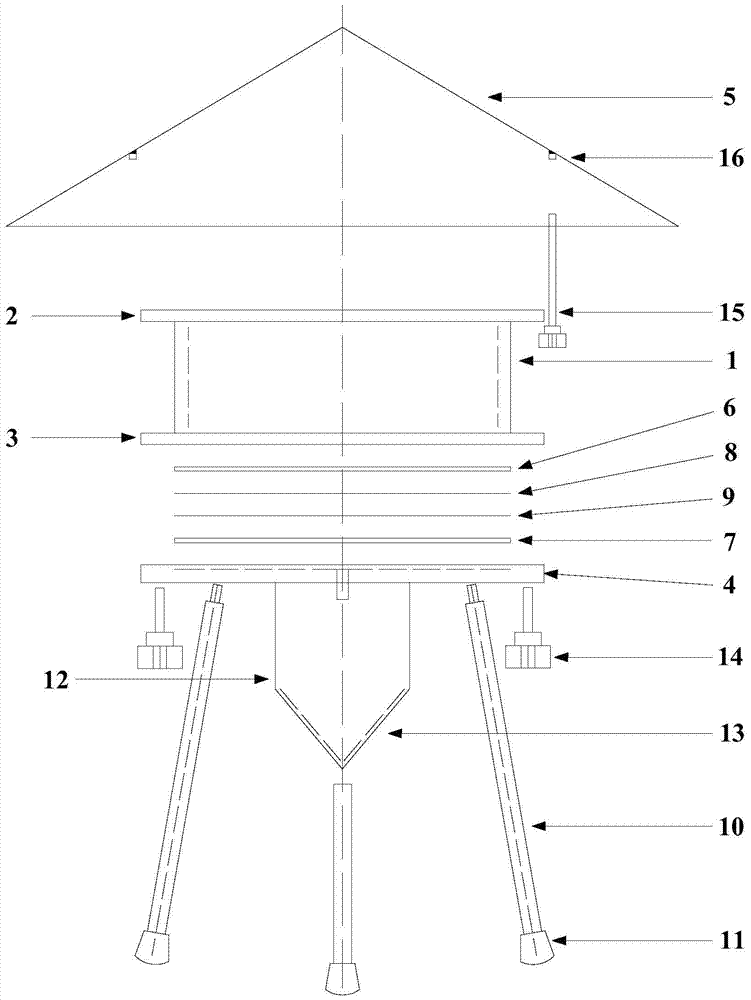A kind of accelerated carbonization tester for polluted soil and its application
A technology of contaminated soil and test equipment, applied in the field of contaminated soil remediation, can solve problems affecting the authenticity and accuracy of test results, affecting the contact area, soil samples or test pieces with different degrees of carbonization, etc., to avoid deviations in test results, avoid The effect of cross contamination
- Summary
- Abstract
- Description
- Claims
- Application Information
AI Technical Summary
Problems solved by technology
Method used
Image
Examples
Embodiment 1
[0063] A contaminated soil accelerated carbonation tester, its structure is as follows figure 1 As shown, it includes a water-retaining top plate 5, a sample chamber and a base that are sequentially connected from top to bottom. The sample chamber includes a cylindrical sample chamber body 1, and sample chamber upper end flanges 2 that are respectively arranged at the upper and lower ends of the sample chamber body 1. And the flange 3 at the lower end of the sample chamber, the water retaining top plate 5 is in the shape of a straight conical surface, and is covered on the upper end of the sample chamber. The top bolt 15 of the sample chamber is connected to the flange 2 at the upper end of the sample chamber, and the lower end of the flange 3 at the lower end of the sample chamber is provided with a first groove, and a matching Teflon O-ring at the end of the sample chamber is provided in the first groove 6. The upper end of the base flange 4 is provided with a second groove,...
Embodiment 2
[0065] Utilize the polluted soil accelerated carbonization tester described in embodiment 1 to carry out the test, simulate the long-term curing effect of different curing agents on soil pollutants when the carbon dioxide concentration rises on a longer time scale, the simulation test process is as follows:
[0066] (1) Contaminated soil solidification treatment and maintenance
[0067] Three kinds of curing agents were used to solidify the contaminated soil. The three curing agents were Portland cement with a strength grade of 42.5, quicklime, and quicklime / fly ash (mass ratio 1:1). The heavy metal contaminated soil was collected from Pudong, Shanghai. In the new area, the addition ratio of curing agent is 10%, and the water-cement ratio is 1:3. Each curing agent is set to be repeated 12 times, with a total of 36 samples;
[0068] Take by weighing 1620g soil (wet weight) and 162g solidifying agent for each sample, measure 51ml deionized water; Put the weighed polluted soil, s...
Embodiment 3
[0089] Utilize the polluted soil accelerated carbonization tester described in embodiment 1 to carry out the test, simulate the long-term stabilizing effect of different stabilizers on soil pollutants when the carbon dioxide concentration rises on a longer time scale, the simulation test process is basically the same as embodiment 2, different The advantage is that:
[0090] (1) Stabilization treatment and maintenance of contaminated soil: select three stabilizers to stabilize the contaminated soil, the three stabilizers are quicklime, sodium sulfide and dipotassium hydrogen phosphate respectively, and each stabilizer is set to repeat 6 times , a total of 18 samples were cured at room temperature for 7 days, and the other parameters and procedures remained unchanged;
[0091] (3) Accelerated carbonation tester installation and sample placement
[0092] (2) Put the contaminated soil samples after stabilization treatment: After the curing is completed, put the three replicate s...
PUM
 Login to View More
Login to View More Abstract
Description
Claims
Application Information
 Login to View More
Login to View More - R&D
- Intellectual Property
- Life Sciences
- Materials
- Tech Scout
- Unparalleled Data Quality
- Higher Quality Content
- 60% Fewer Hallucinations
Browse by: Latest US Patents, China's latest patents, Technical Efficacy Thesaurus, Application Domain, Technology Topic, Popular Technical Reports.
© 2025 PatSnap. All rights reserved.Legal|Privacy policy|Modern Slavery Act Transparency Statement|Sitemap|About US| Contact US: help@patsnap.com

